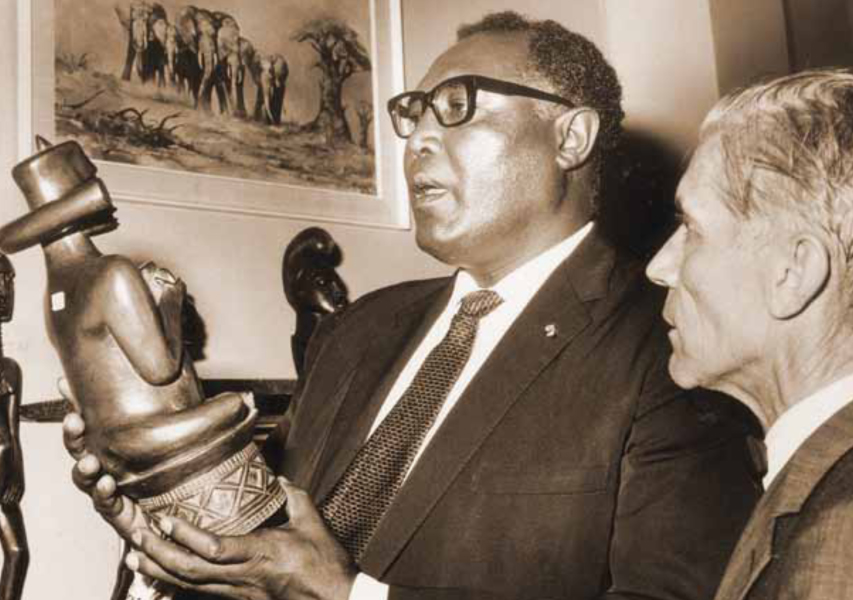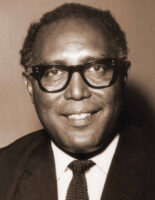
Joseph Zuzarte Murumbi was appointed second Vice-President in May, 1966, following the fallout between President Kenyatta and Vice-President Odinga. Earlier, Murumbi had been independent Kenya’s first Foreign Affairs Minister.
Murumbi was born in 1911 at Londiani, Kericho, to a Goan trader and a Maasai woman. In a media interview, he remembered his mother as a polyglot who spoke Maasai, English, Hindustani, Lumbwa and Kikuyu. He spent the initial years of his life in India. He left Kenya when he was only six years old — in 1917 — when his father, Peter Zuzarte, shipped the young man to India for a missionary education at a school in Bangalore. When he completed school, he got a job in an ice-making factory.
He worked for the administration of Somalia between 1941 and 1951 and was the assistant secretary for the Movement for Colonial Freedom between 1951 and 1957. Murumbi then worked as the Press and Tourist Officer in the Moroccan Embassy in London. In Kenya, he met Pio Gama Pinto at a public meeting in 1952, in which Murumbi had “persistently but unsatisfactorily” sought answers from a speaker. Later, Pinto introduced himself and theirs developed into a sincere friendship that lasted until Pinto was gunned down in 1965.
Pinto introduced Murumbi to the Kenya Study Group, a small group of politicians and others who met regularly to assess the political problems of the day. Pinto inspired Murumbi into politics. The declaration of the State of Emergency on October 20, 1952, led to the detention of the top leadership of the Kenya African Union. Murumbi thus became the party’s acting secretary-general.
Murumbi played a key role in securing legal counsel for the core group of detainees arrested in the Emergency crackdown (the Kapenguria Six), including Kenyatta. During his six-month stay in India at the height of the emergency in 1953, Pinto sent him Press cuttings and commentaries on the local political situation every week, information Murumbi used in his anti-colonial campaigns in India and later Cairo and London. With Pinto’s help, he made the world aware of the brutal nature of British imperial rule in such Indian newspapers as The Chronicle.
In 1962, he became the Kanu treasurer and in the 1963 elections, he was elected to the House of Representatives for Nairobi South. In the first Cabinet, in 1963, he was appointed Minister of State in the Prime Minister’s office.
In his eulogy of Pinto, he concluded: “He was quick to react to injustice. If such were the qualities of this patriot and he was branded a communist for his actions, then I must say to his accusers that their perception of political dogma is, indeed, distorted.”
Murumbi was a rare breed of nationalist who wanted to serve his country with honour and dignity. But he found out that honesty and character did not make for a successful politician. Those in Government had different views on how to conduct business.
But Murumbi, an upright politician who hated corruption and political intrigue, refused to follow the pack and resigned in November, 1966, after only seven months in office. However, Kenyatta did not want Murumbi to leave government.
In a press interview before Murumbi died in 1990, the former VP narrated how an obviously hurt Kenyatta “walked away” from him without a word when he told him he would resign.
Murumbi was succeeded by Moi who went on to succeed Kenyatta upon his death in 1978.
But, apart from disagreeing with the premium politicians had placed on self as opposed to service, Murumbi’s resignation was to a large extent out of bitterness with the assassination of his friend and mentor, Pio Gama Pinto. A year after Pinto was murdered Murumbi wrote a heart-rending appreciation, describing him as a friend of the poor and the downtrodden. He wrote: “All over the country, men still remember his generosity. He gave all he had to help the poor. He gave and asked for nothing in return. He died a pauper.”
Murumbi noted that Pinto’s enemies had accused him of being a communist, “but even if he were, surely in a democratic Kenya, that is not a crime warranting death to follow any political persuasion”. He described his fallen friend as a socialist “who lived his socialist beliefs in thought and deed”.

After buying his first collector’s item at a shop in London in the early 1960s, Murumbi became an avid art collector. By the time he died, he had collected over 50,000 books and official correspondence. The Kenya National Archives has set up a library of 8,000 rare books (published before 1900), which were entrusted to it by Murumbi.
Murumbi co-founded the African Heritage with his wife Sheila and friend Alan Donovan. It has become Africa’s largest Pan-African art gallery. Joe, as his friends fondly knew Murumbi, turned down huge offers from overseas bidders for his vast art collection. Instead, he sold it to the Kenya Government at a concessionary rate. And he gave conditions — that the collection would be preserved at his Muthaiga home, which would be expanded to become the Murumbi Institute of African Studies, with a library, a hostel and a kitchen.
Unfortunately, the Government sub-divided the land and allocated it to developers, an action that deeply shocked Murumbi. It is said that he never recovered from the shock when he visited the site and found developers turning it into real estate. At this stage, he moved to live among his maternal people, the Maasai, near the Maasai Mara Game Reserve, where he built what his friend Alan Donavan once described as a “stunning” house. In 1982, Murumbi fell in his bathroom and damaged his spine. He was evacuated to Nairobi and confined to a wheelchair.
Murumbi died in 1990 following a heart attack. His wife Sheila died in October, 2000. They are buried next to each other outside the City Park Cemetery. Burial at the City Park, close to his friend Gama Pinto’s grave, was Murumbi’s last wish. But the cemetery was full and his wife was allowed to bury him outside the park near his friend’s grave.
On March 29, 2009, the Murumbi Peace Memorial was opened at the Nairobi City Park. It encloses the graves of Joseph and Sheila Murumbi as well as a sculpture garden created by pioneer East African artists whose works are in the Murumbi collection. The memorial is one of the few places where sculptures by leading African artists can be viewed in an open space.
In the 1980s, the Murumbi Trust received a Ford Foundation grant of $50,000 (Kshs4 million at the current exchange rate) to restore, interpret, preserve and label the historic collection of political, artistic, textile, material and cultural artefacts, now displayed in permanent glass showcases at the Kenya National Archives. The gallery allows locals and visitors to learn about the continent’s creative and cultural diversity.
Murumbi’s, one of Africa’s richest art collections, is estimated to have 8,000 items. But a note pinned to his personal display case points out that “the collection herein is still in progress, still awaiting more memorabilia and awards given to the revered collector”.
The collection is in three parts — books or publications, records and material culture. He collected more than 2,000 rare books on African history, expeditions and travels. The records include those he collected in his official capacity in government and personal letters and cards. These are in the private archives, but the books are displayed in the Murumbi Africana Book Library alongside the National Archives Library. The material culture includes a wide range of original items collected from West, Central and East Africa. They cover every aspect of human activity and artwork. The collection also includes mythology, magic, weaponry and farm inputs. There are items made from wood, stone, clay, ivory, hides and skins, bronze, brass and even bones.
Murumbi had a keen eye for rare African artefacts, such as the mono print titled Young Girl by renowned Nigerian Muraina Oyelami, and the Ejiri carvings credited to Ijo artists, which reflect traces of ancient cubism as a prevalent art form in the Niger Delta. Equally impressive are the wooden Gelede masks whose gigantic heads are elongated in a traditional style. The Gelede mask was used during special ceremonies held to worship the beauty of womanhood and witchcraft among the Yoruba.
Also in the collection are Yatenge masks and clay pots styled in human form common among the Bobo of Burkina Faso, Cote d’Ivoire’s Baoule and Senoufo masks. There are also Nimba masks from Guinea, female masks from Sierra Leone used by the Mende during girls’ initiation rites. Several cotton appliqué pieces of Nigerian artist Samuel Ojo are on display alongside Mammy Wata carvings, which represent a water spirit used for entertainment and cult masquerades in eastern Nigeria. Produced by Ibibio carvers, some of the appliqués have mermaid-type tails, while others are wrapped in snake shapes meant to depict priestesses or diviners.
Paintings by one of Africa’s acclaimed arists, Bruce Onobrakpeya, are also in the Murumbi collection. Closer to home are Makonde ivory, stone and ebony sculptures, whose distinctive shapes depict men or women in suggestive poses. Murumbi collected the pieces from Tanzania. One of Kenya’s pioneer wood sculptors, Francis Muthuri Amundi, is represented by a piece relating the genesis of the Agikuyu community. At its base is the primordial woman in the throes of childbirth, while the shape of nine breasts is symbolic of the girls who gave birth to the clans of the community.
The maternal theme is also present in veteran Kenyan artist Rosemary Karuga’s clay sculpture Mother and Child. Other compatriots include the ceramist/clay potter Magdalene Odundo, and little-known Louis Mwaniki, whose hilarious pencil work sits beside Elkana Ongesa’s soap and granite stone sculptures.
Other sculptures from West Africa include the Guinean Anok’s bird-like pieces, soap stone sculptures from Sierra Leone, Cote d’Ivoire’s Senoufo depicting a Calao ancestral bird regarded as a symbol of leadership, a Bawa owl mask from Burkina Faso and terra cotta clay sculptures from Cameroon.
From this side of the continent are the Ugandan Francis Nnagenda’s gigantic wooden sculptural art and John Odoch’ameny’s molten metal sculptures. Uganda is also represented by Eli Kyeyune’s oil on canvas portraits dated between 1965 and 1967, and Sudan by gouache on goatskin art pieces by Salih Mashamoun, a diplomat in Nairobi in the mid-1970s. Ancient Ethiopian religious art in mural-like designs is displayed next to rare pieces of Coptic etchings.
